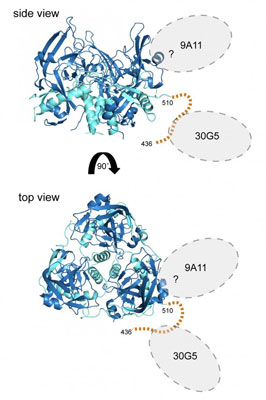Researchers find new antibodies that protect against Marburg virus
Posted: 29 June 2015 | Victoria White
A study led by scientists at The Scripps Research Institute has identified new immune molecules that protect against Marburg virus, a relative of Ebola…

The team found antibodies that identify and neutralise Marburg virus — which inflicts a mortality rate of up to 90 percent. Credit: The Scripps Research Institute.
A new study led by scientists at The Scripps Research Institute (TSRI) identifies new immune molecules that protect against the deadly Marburg virus, a relative of Ebola.
The research provides ingredients needed to develop treatments for future Marburg outbreaks.
“These antibodies attack a new site on Marburg virus we had not seen before,” said Erica Ollmann Saphire, professor at TSRI and director of the Viral Haemorrhagic Fever Immunotherapeutic Consortium.
Currently, there are no vaccines or treatments specifically for Marburg infections.
The new study builds on previous work in Saphire’s lab revealing a molecular structure that Marburg virus uses to attach to and enter host cells.
Researchers designed proteins which elicited new antibodies developed at Emergent BioSolutions. Other antibodies in the study were independently identified at Mapp Biopharmaceutical and Integrated Biotherapeutics, which collaborated with TSRI for molecular analysis.
Some of the new antibodies target a site on Marburg virus not seen before—a wing-like feature attached to the base of the virus. Antibodies against this newly discovered site protected 90 to 100% of infected animal models from lethal infection.
Some antibodies discovered in the new study are also able to cross-react with Ebola virus and its four relatives in the Ebolavirus genus.
Cross-reactive antibodies could be used as diagnostics for newly emerging strains of ebola virus and Marburg virus
“We expect both Marburg virus and Ebola virus to emerge again and to acquire new mutations,” said TSRI Research Assistant Marnie Fusco. “The cross-reactive antibodies could be used as diagnostics for newly emerging strains.”
“The high cost of creating independent vaccines or treatments for each of the different viruses in this family necessitates intelligent design of immunogens (antibody-inducing molecules). The molecular images used to design the molecules and evaluate the antibodies point the way forward,” added Jody Berry, the former Director of Pipeline Research of Emergent BioSolutions.
“Understanding where and how the antibodies interact with the virus tells us which regions can be targeted and helps us develop lead candidates for clinical development,” said Cory Nykiforuk, current director of pipeline research of Emergent BioSolutions. “There are multiple filoviruses that threaten our communities, front line medical workers and defense personnel, and bringing new technologies to the forefront could potentially help meet future requirements.”
The study findings are published in PloS Pathogens.
Related conditions
Ebola
Related organisations
The Scripps Research Institute (TSRI)


